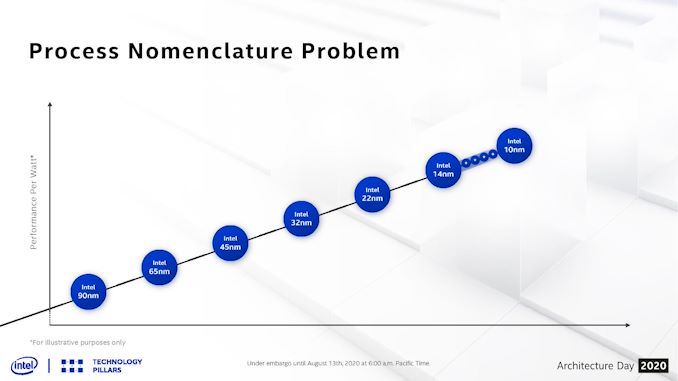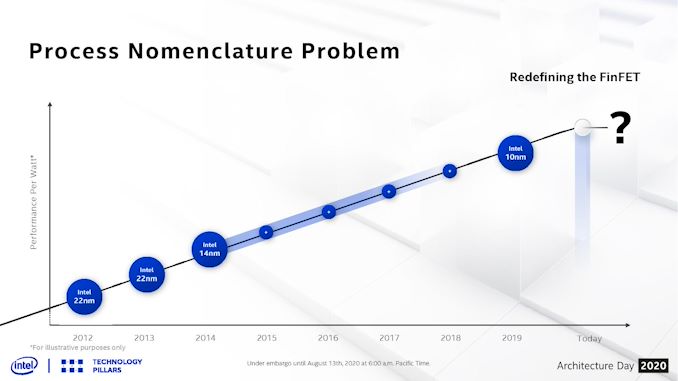What Products Use Intel 10nm? SuperFin and 10++ Demystified
by Dr. Ian Cutress on September 25, 2020 9:00 AM EST_678x452.jpg)
For our audience that regularly keeps track of Intel’s product portfolio, it would be hard to miss that the naming strategy of Intel’s process node technologies is a bit of a mess. To some, those words are themselves an understatement, as Intel has shifted its naming strategy 2-3 times since the launch of Intel’s first 10nm products. Not only that, even Intel’s various departments internally have a hard time keeping track of ‘what is this manufacturing process being called today’ when the press like AnandTech ask for details on the latest upcoming products.
Knowing this, and knowing what issues Intel has been having, I wanted to demystify Intel’s manufacturing process naming scheme such that users and engineers alike, even if they are inside Intel, can understand what is what but also importantly why. The why is the crucial factor.
If you're looking for a handy decoder ring for Intel's 10nm Products, it's here in page 3.
Why Do We Have Multiple Versions of a Process?
With Intel’s 14nm, we were invited to 14nm, 14+, 14++, 14+++, and if you believe Intel’s own slides, there were variants that went beyond this ++++ naming scheme. Each one of those additional + points on the end of the name signified a change in the process technology – usually to assist for increasing performance or efficiency.
Each one of these + points is an update to the BKM, or Best Known Methods.
While an engineer can draw an electrical layouts for a part of a processor, such as an addition circuit, actually applying that design to a silicon floorplan for manufacturing is a different skill altogether. Transistor libraries are designed to take advantage of a given process, and when a floorplan is optimized for a process, it can then be pasted and repeated as necessary – on top of this, simulation on thermals, power, and current density are applied to ensure that there are no hotspots or that critical paths inside the design have as few bottlenecks as possible.
When an update to the BKM occurs, two things can happen. Normally we see the update on the level of the transistor library that is changed – if the distance between two fins on a transistor increases for example, the transistor library and the macros may be made bigger, and then the floorplan might be redesigned to take account for this. As for any process node design, there are 100 different controls, and improving one might make three other controls worse, so it is a fine balancing act. Not only this, but the BKM has to be validated at the manufacturing level. The BKM update could apply to the metal stack as well, which in of itself can adjust the performance.
In the long long past, BKM updates were never advertised externally. If Intel or TSMC or another foundry discovered a way to improve the performance, or decrease the voltage, or improve the yield, the update was silently rolled into the design and nothing much was made of it. Sometimes processors would be listed as ‘1.0 volts to 1.35 volts’, and it would just be a roll of the dice if a user obtained one of the lower voltage models.
However, as time between different process node updates has elongated, these BKM updates have started to be identified and effectively monetized by the semiconductor companies. An update to a process that improves the voltage by 50 millivolts and increases frequency by 200 MHz immediately becomes a productizable event, and products built on these updates can be offered for more money over the usual. Or, depending on the rate of updates, the whole next generation of products could be built on the update.
So we never saw BKM updates officially announced at Intel’s 45nm, 32nm, or 22nm process nodes. These updates were fast enough that the productization of any update didn’t warrant a full round of marketing. With 14nm, that changed.
Intel had discussed its roadmap beyond 14nm since its 2010 Investor Meeting. It predicted that the company would be on 14nm by 2013, 10nm by 2015, and 7nm by 2017. As we now know, 14nm was two years late, and 10nm was 2-4 years late. Because of the introduction of 10nm being delayed, Intel decided to productize its 14nm BKM updates, and signified those with + points.
Intel’s current official line is that there have been four updates to 14nm, creating five ‘generations’.
More Plus Means More Meme
Because of all the + points, Intel’s marketing sometimes getting it wrong, and perhaps a little bit of ‘++’ in most programming languages meaning ‘+1’, the whole concept of adding + to the process node has become a meme – a meme at Intel’s expense, purely on the basis of its failure to deliver 10nm before the 14++++ naming scheme got out of hand.














143 Comments
View All Comments
eastcoast_pete - Saturday, September 26, 2020 - link
Intel used to be run and lead by real subject matter experts - people with Ph.D.s or Master degrees in chemistry, physics or material sciences. I wonder which business school that executive got his degree from, but he embodies the approach that subject matter Know-how isn't really required to run a place. Unfortunately, the destination is then often "the ditch".FunBunny2 - Wednesday, October 7, 2020 - link
"business school that executive got his degree from, but he embodies the approach that subject matter Know-how isn't really required to run a place."the mantra of the typical, i.e. Ivy League, MBA - "Managing is a separable skill, can be applied to any business, and we are the masters of managing." that's why most American business has been shifted out-of-country: it saves a few pennies per unit. China didn't steal American jobs, the MBAs gave them away (Nixon "opened" China for the cheap labour, not its 'consumer' market which didn't exist), since it was no skin off their noses. in due time, only MBAs will have moolah to buy all that Chinese made stuff.
Spunjji - Friday, September 25, 2020 - link
Thanks for this article. It's good to see it all laid out.six_tymes - Friday, September 25, 2020 - link
on one hand I get it, you are venting and frustrated like so many others. on the other hand, get a life. you are making a mountain out of a molehill. They have already recognized the naming scheme issue, and as you said its a big company and it takes time to correct and do better, they are in process of doing so, drop it already and MOVE ON.Ian Cutress - Saturday, September 26, 2020 - link
Get a life? What? You're not privy to the dozens of emails going back and forth about what products are what process nodes because they keep being corrected and recorrected. I've had financial analysts, those who follow this stuff but perhaps not to the detail we do, reach out and say that this article makes it a lot easier to understand the what and the why. So yeah, get a life. Sure thing bud.Spunjji - Monday, September 28, 2020 - link
"MOVER ON" is the favourite slogan of the gaslighter. It's getting quite funny seeing the overlap between Intel defenders and Brexit shills.eastcoast_pete - Friday, September 25, 2020 - link
Now the "+++++" era is over, get ready for "10 nm super-duper fin" and "10 nm hyperfin"; "10 nm ultimate fin" is also a distinct possibility.Spunjji - Monday, September 28, 2020 - link
M-M-M-M-M-M-MONSTER FINFin
fin
ilkhan - Friday, September 25, 2020 - link
Y'all are aware nvidia announced some new gpus, right?Rudde - Saturday, September 26, 2020 - link
California wildfires happened and the gpu reviews were delayed.